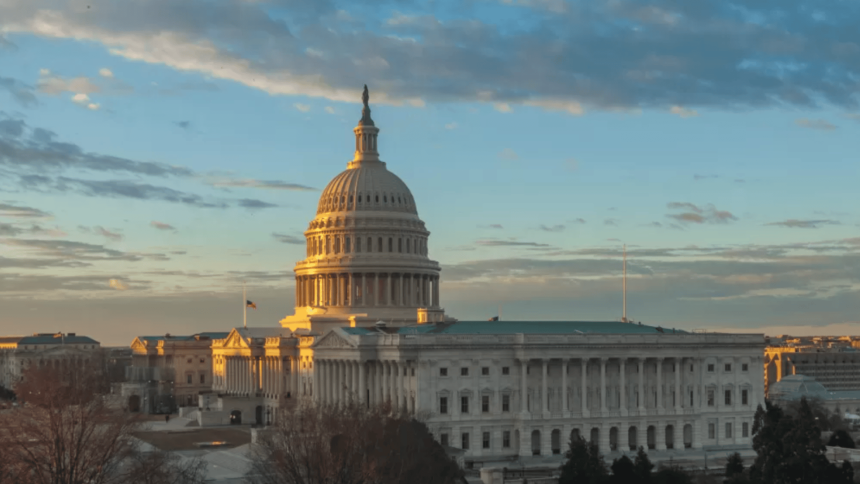The views expressed by contributors are their own and not the view of SuperTalk Mississippi Media
“There you go again.”
Who could forget that famous quip from candidate Ronald Reagan during the last debate before the 1980 presidential election? The candidates were discussing Medicare. I long for the days when debates focused on policy, but I digress.
During the 1980 campaign, Carter falsely and repeatedly suggested Reagan wanted to end Medicare immediately. Thus, Reagan’s retort. Reagan would go on to win the presidency in a landslide, capturing the majority of the popular vote and 44 states.
So, what does Reagan’s reply to Carter have to do with the debt ceiling? First, let’s define “debt ceiling.”
What is the debt ceiling?
Often referred to as the debt limit, it’s merely a cap on the amount of money the U.S. Treasury is authorized to borrow.
The debt ceiling has been raised 78 times since it was instituted by Congress in 1917, as a more efficient way to finance World War I. Before the statutory implementation of the debt ceiling, Congress had to authorize the Treasury to borrow money by issuing various debt instruments. Congress has raised the debt ceiling 20 times since 2001.
On January 19th, 2023, the U.S. maxed out its credit card at $31.4 trillion, necessitating an increase in the debt ceiling, thus allowing the Treasury to borrow money to meet its obligations. So here we go again.
Why has the debt ceiling turned into a political football?
It’s primarily a function of divided government, where since the midterm elections last November, Republicans control the U.S. House of Representatives, and the Democrats have the advantage in the Senate and the White House. An increase in the debt ceiling requires legislation to pass both houses of Congress and the President’s signature.
Thus far, parties have drawn lines in the sand.
Since being elected to the top position in the Chamber after 15 rounds of voting, Speaker of the House Kevin McCarthy has insisted that any agreement to increase the debt ceiling must include cutting out-of-control federal spending.
The President and Senate Leader Chuck Schumer contend that House Republicans should agree to increase the debt ceiling with no strings attached, such as reductions in spending.
How does the government operate without being able to borrow money?
Unfortunately, revenues collected by the federal government do not keep pace with expenses. The shortfall necessitates that the government borrows money to make ends meet. It’s important to understand that raising the debt limit is required to fund prior obligations already enacted into law. Since sufficient revenues are not available to cover government spending, the Treasury puts it on the credit card. This debate isn’t about funding new spending whatsoever.
In fact, the need to fund prior legislative commitments is the Democrat’s primary argument for being unwilling to negotiate spending cuts to secure Republican support for lifting the debt cap.
Since the limit was hit earlier this month, the Treasury Department has used “creative accounting” to keep the government running. Treasury Secretary Janet Yellen reports that her agency is using “extraordinary measures” to pay the government’s bills. Specifically, Treasury is pausing investments in various government retirement funds and using cash reserves to stay afloat.
But these schemes will only carry the government so far. The day of reckoning is approaching and is estimated to be in early June.
What is the difference between the federal deficit and debt?
The terms “deficit” and “debt” are often conflated and confused. The two concepts are distinct and exclusive in meaning.
Calculated on an annual basis, the deficit begins at zero dollars at the start of each fiscal year. Specifically, the deficit is the amount by which federal spending exceeds tax revenues.
The national debt is the sum of past deficits, plus other federal borrowing, less any debt principal repaid by the Treasury. Unlike deficits which are measured annually, the nation’s debt is cumulative. In comparison to a private entity, deficits are equivalent to net losses on an income statement measuring a specified period, whereas federal surpluses are tantamount to net profit. Debt is presented on an organization’s balance sheet in the liability section as a running total.
How did our debt get so high?
The simple explanation is that our government spends more money than it takes in. The U.S. has produced deficits in 48 of the last 52 years, with only the period 1998–2001 posting surpluses. It is important to note that nearly a third of our debt was added during the Covid era.
See the chart below which shows our annual deficits and debt balance at the end of each fiscal year, starting in 2017.
| Year | Annual Deficit (In billions, Rounded) | Debt Balance
(In billions, Rounded) |
| 2017 | $665 | $20,245 |
| 2018 | $779 | $21,516 |
| 2019 | $984 | $22,719 |
| 2020 | $3,132 | $27,748 |
| 2021 | $2,772 | $29,617 |
| 2022 | $1,420 | $30,824 |
It boggles the mind that discussions concerning government financial figures are denoted in trillions. The nation’s fiscal year ends September 30. Since then, about $580 billion has been added to the debt, hitting the $31.4 trillion limit reached earlier this month. Currently, the total debt per citizen is approximately $94 thousand, or just under $250 thousand per taxpayer.
When reviewing the above chart, observe that year-over-year debt increases more than the annual deficit. That’s because for years Congress has borrowed from surpluses generated by Social Security, which emerged in the 1980s when more people were working (paying into SS via payroll taxes) than there were retirees (receiving SS benefits). However, that trend is rapidly reversing as our population ages and life expectancy increases while fewer people are entering the workforce.
Many believe that Congress has “stolen” money from Social Security, jeopardizing the program’s ability to meet future benefit obligations. But that simply isn’t true.
First, the law requires the Social Security Trust Fund to invest its surplus by selling special Treasury bonds that are guaranteed by the U.S. government. Second, every penny loaned has been paid back by the government – with interest. Social Security receives interest payments and redeems these special bonds continuously from the Treasury. A default would not only crash Social Security, but it would also lead to global economic collapse.
Who owns our debt?
There are two broad categories of federal debt, as classified by the U.S. Bureau of Public Debt: intragovernmental debt and debt held by the public.
Intragovernmental debt consists of the Treasury’s liabilities to other government agencies, such as Social Security and other public pension programs.
Debt held by the public includes amounts owed to investors in U.S. Treasury bills, notes, and bonds – debt instruments with varying maturities ranging from a few days to 30 years. Investors who hold federal debt include individuals, financial institutions, corporations, Federal Reserve Banks, state or local governments, and foreign governments.
Of the nation’s total $31.4 trillion of outstanding debt, $6.8 trillion is intragovernmental and $24.6 trillion is held by the public. In other words, we owe ourselves.
Most Americans mistakenly believe that the government borrows mostly from China. Total foreign-held debt stands at just over $7.4 trillion or 23.5% of total debt. America owes China $870 billion, or 11.7% of total debt held outside of the U.S., representing 3.5% of debt held by the public and 2.7% of total federal debt. Japan is the largest holder of U.S. Treasuries at $1.08 trillion.
What spending are Republicans proposing to cut?
Good question. Democratic leaders have implored McCarthy to produce a plan showing proposed spending cuts necessary to garner House Republican support for increasing the debt ceiling.
“I want to find a reasonable and a responsible way that we can lift the debt ceiling but take control of this runway spending,” McCarthy said, later adding, “I don’t think there’s anyone in America who doesn’t agree that there’s some wasteful Washington spending that we can eliminate.”
Cutting spending is a trickier task than what meets the eye.
Federal outlays are comprised of two broad categories: mandatory and discretionary. Mandatory spending programs are statutory, authorized by permanent law, and on “autopilot,” in that they do not require annual appropriations by Congress. Mandatory spending consists of Social Security, Medicare, Medicaid, federal civilian and military retirement benefits, and a host of subsidies, credits, and other benefits. Mandatory spending plus debt interest consumes over 70% of total spending.
Discretionary spending is authorized annually by Congress, accounting for the remaining 30% of total spending. Discretionary programs for 2023 were recently funded by the $1.7 trillion Omnibus Appropriations Bill which passed on December 30, 2022. Coming in at over 4,000 pages, the bill provides $858 billion for defense and $787 billion for nondefense spending, which covers the cost of the monstrosity that is the government agency complex. This represents a 9% increase over 2022 discretionary spending.
Late Sunday it was announced that the President and Speaker McCarthy will meet to discuss a plan.
“The President will ask what the Speaker’s plan is, since the first bill he put on the floor would increase the deficit by more than $100 billion in order to protect wealthy tax cheats and other proposals from House Republicans would cut Social Security, Medicare and other critical programs that working families and seniors have earned,” a White House official stated.
McCarthy has repeatedly stated that he’s not suggesting cuts in Social Security and Medicare. However, a group of House Republicans have proposed raising the eligibility age for the programs. Democrats have taken note. Many Republicans have also said they oppose cuts to defense, which just got a 10% boost over 2022.
With mandatory spending, again 70% of the total, off the table, what cuts from the discretionary basket will McCarthy propose to trim? Most Americans would like to see the budget balanced. Here are some data nuggets related to that lofty goal:
- 83% of all discretionary spending would have to be cut to balance the budget in 2023.
- Cutting the entire Department of Defense plus debt interest would still leave a $200 billion deficit.
- If Medicaid and Medicare were shut down, the deficit would be $100 billion.
- The deficit could be reduced by $100 billion, to $1.3 trillion, if the U.S. stopped sending aid abroad.
- According to the Committee for a Responsible Federal Budget (CRFB), 51% of all spending except defense, veterans benefits, and Social Security would have to be cut to balance the budget by 2032.
- The CRFB also maintains that by balancing the budget without increasing revenue (taxes), spending would have to be reduced by 26% over the next decade.
What do the Democrats want to do about the spending?
Increase it. Democrats believe that our deficit is 100% caused by the lack of revenue, specifically the Tax Cuts and Jobs Act of 2017 (TCJA), commonly known as the Trump tax cuts. Red meat for the Democrat base, but totally false. Revenues have increased under the TCJA, though the Congressional Budget Office (CBO) scored the bill to reduce revenues by $1.5 trillion…over 10 years or $150 billion a year. The CBO’s estimates frequently miss the mark.
The deficit in 2022 was $1.4 trillion. Deficits registered at $2.8 trillion in 2021 and $3.1 trillion in 2020. Recall that not so long ago, the federal government was dropping money out of helicopters in the name of Covid relief, necessitated by misguided government shutdowns. Both parties wholeheartedly supported two giant Covid bills in 2020 which were enacted with President Trump’s signature.
The Covid spending continued in 2021, nearly tripling the pre-pandemic deficit in 2019. The totally unnecessary $1.9 trillion American Rescue Plan passed on a party-line vote in 2021 when Democrats handed Joe Biden his first major legislative victory. Biden bragged about cutting the deficit by $300 billion to ONLY $2.8 trillion ($2,800,000,000,000). We’ve become desensitized to the value of trillion. And, if you’re counting, that’s a thousand billion or twelve zeros.
It takes Democrat “fuzzy math” to attribute the deficits to the TCJA.
Their plan seeks to dramatically increase income taxes and payroll taxes (Social Security and Medicare). Democrats would love to enact a wealth tax, which is the Democrat’s holy grail. When it comes to taxes, leftists are exceptionally creative.
What’s likely to happen?
Not much. Republicans control half of one-third of the federal government. Democrats will never go along with spending cuts to anything but defense, which is off-limits to Republicans. Conversely, it’s unlikely that Republicans will allow the government to default on its obligations by not increasing the debt ceiling. Americans would likely ascribe culpability to Republicans just as the 2024 election gets rolling. Democrats succeeded with that strategy in 2011, though they did get President Obama to agree to some long-term spending reform. We will likely see agreement for moderate spending cuts and lifting the debt ceiling sufficient to carry the nation’s credit through the end of the fiscal year.
At a minimum, House Republicans could scrub every line item of the federal budget for waste, fraud, and abuse, including mandatory spending, where the CBO estimates $50 billion of annual improper payments in Medicare alone. Funding should be cut to the Department of Defense for social justice programs, such as privilege walks in the Air Force. The list is long.
The solution is to elect fiscal hawks to the House, Senate, and White House in 2024. It’s especially important to elect Republicans to the Senate who won’t aid the Democrats with their reckless spending, such as the 18 GOP Senators who supported the recently enacted $1.7 omnibus spending bill. If voters continue to reward representatives and senators who “bring home the bacon,” our nation’s deficit and debt will persist.
With control of the House, Republicans can indeed hold the line on any new radical spending. Let’s hope Speaker McCarthy honors his commitment and puts the Biden agenda on ice for a couple of years.








